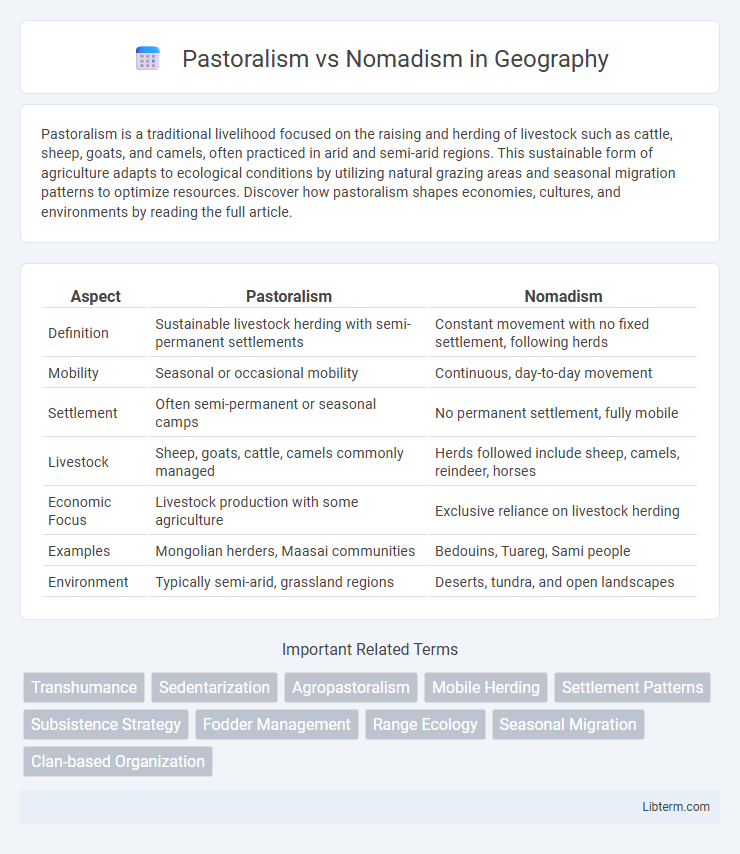Pastoralism is a traditional livelihood focused on the raising and herding of livestock such as cattle, sheep, goats, and camels, often practiced in arid and semi-arid regions. This sustainable form of agriculture adapts to ecological conditions by utilizing natural grazing areas and seasonal migration patterns to optimize resources. Discover how pastoralism shapes economies, cultures, and environments by reading the full article.
Table of Comparison
| Aspect | Pastoralism | Nomadism |
|---|---|---|
| Definition | Sustainable livestock herding with semi-permanent settlements | Constant movement with no fixed settlement, following herds |
| Mobility | Seasonal or occasional mobility | Continuous, day-to-day movement |
| Settlement | Often semi-permanent or seasonal camps | No permanent settlement, fully mobile |
| Livestock | Sheep, goats, cattle, camels commonly managed | Herds followed include sheep, camels, reindeer, horses |
| Economic Focus | Livestock production with some agriculture | Exclusive reliance on livestock herding |
| Examples | Mongolian herders, Maasai communities | Bedouins, Tuareg, Sami people |
| Environment | Typically semi-arid, grassland regions | Deserts, tundra, and open landscapes |
Defining Pastoralism and Nomadism
Pastoralism is a form of animal husbandry where livestock such as cattle, sheep, and goats are raised primarily for food, labor, and trade, often involving seasonal movement within a defined territory to access grazing lands. Nomadism is a lifestyle characterized by continuous or cyclical movement without a permanent settlement, where communities migrate to find fresh pastures and water sources for their animals. While all nomads engage in pastoralism, not all pastoralists are nomadic, as some practice transhumance, moving livestock seasonally between fixed summer and winter pastures.
Historical Origins and Evolution
Pastoralism originated around 10,000 years ago during the Neolithic Revolution, with early human societies domesticating animals for food, labor, and materials, marking a significant shift from purely hunter-gatherer lifestyles. Nomadism evolved as a mobile adaptation to varied environmental conditions, with groups like the Mongols and Bedouins developing intricate systems of seasonal migration to optimize resource use. Over millennia, both pastoralism and nomadism have adapted through cultural exchanges, technological advances, and environmental pressures, shaping the social and economic structures of numerous civilizations across Eurasia and Africa.
Key Characteristics and Practices
Pastoralism centers on the domestication and herding of livestock such as cattle, sheep, and goats, often involving semi-permanent settlements to manage grazing resources. Nomadism involves the regular movement of groups or tribes across vast territories without fixed habitation, following seasonal patterns to access water and pasturelands. Key practices in pastoralism include rotational grazing and herd management, while nomadism emphasizes mobility, flexible social structures, and adaptation to diverse environmental conditions.
Geographical Distribution
Pastoralism is predominantly practiced in arid and semi-arid regions such as the Sahel in Africa, parts of Central Asia, and the Andes Mountains, where livestock grazing is adapted to sparse vegetation. Nomadism is commonly found in harsher environments like the Arabian Peninsula, Mongolia, and the Tibetan Plateau, where groups move cyclically across vast territories to access water and pastures. Both practices are shaped by geographic factors including climate, terrain, and resource availability, influencing the mobility patterns and livestock management strategies of communities.
Livelihood Strategies
Pastoralism involves the systematic breeding and management of livestock as a primary livelihood strategy, often practiced in arid and semi-arid regions to optimize grazing resources. Nomadism, while including pastoral elements, emphasizes continuous movement and mobility of communities to access diverse pastures and water sources, ensuring sustainable resource use. Both strategies adapt to environmental variability but differ in settlement patterns and intensity of livestock management to support economic stability.
Social and Cultural Structures
Pastoralism is characterized by semi-permanent settlements where social structures revolve around herd management and kinship-based clans, emphasizing ritual practices tied to livestock. Nomadism features highly mobile groups with flexible social hierarchies, adapting cultural norms to frequent migrations and resource availability. Both systems develop distinct gender roles and communal cooperation, but pastoral societies often maintain stronger territorial ties than nomadic groups.
Environmental Impact
Pastoralism typically involves the management of domesticated livestock within a defined territory, which can lead to sustainable grazing patterns that promote soil fertility and biodiversity conservation. Nomadism, characterized by regular movement of herds across vast landscapes, often helps prevent overgrazing by allowing vegetation in previously grazed areas to regenerate. Both practices influence ecosystem dynamics differently, with pastoralism potentially causing localized environmental degradation if mismanaged, while nomadism contributes to habitat connectivity and resilience in arid and semi-arid regions.
Challenges and Adaptations
Pastoralism faces challenges such as overgrazing, climate variability, and land conflicts, which threaten sustainable livestock management. Nomadism contends with restricted mobility due to modern boundaries and environmental degradation, necessitating adaptive strategies like rotational grazing and diversified income sources. Both systems develop resilience through traditional knowledge, social networks, and flexible resource use to withstand socio-environmental pressures.
Contemporary Relevance
Pastoralism remains a crucial livelihood for over 200 million people worldwide, especially in arid and semi-arid regions where crop farming is challenging. Nomadism, although less common today, continues to shape the cultural identity and land-use practices in parts of Central Asia and Africa. Both systems contribute to biodiversity conservation and sustainable management of rangelands in contemporary environmental and socioeconomic contexts.
Future Prospects and Sustainability
Pastoralism and nomadism face evolving challenges and opportunities in sustainability due to climate change impacts and shifting land-use patterns. Integrating traditional knowledge with modern sustainable practices can improve resource management and resilience in arid and semi-arid regions. Future prospects depend on adaptive strategies that balance ecological conservation with the socio-economic needs of pastoralist and nomadic communities.
Pastoralism Infographic

 libterm.com
libterm.com